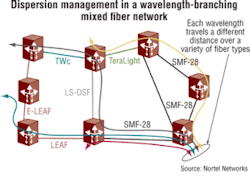Three approaches to solving dispersion compensation at 10G
Certain optical impairments are inherent in 10-Gbit/sec optical networks. The first is attenuation or a decrease in signal strength as the signal travels over the optical link, requiring the use of amplification. As multiple amplifiers are cascaded to achieve a longer transmission distance, other optical impairments occur, including chromatic dispersion and polarization mode dispersion (PMD), which result in a spreading or broadening of the signal due to the propagation of different wavelengths at different speeds.
Many vendors have developed technologies to mitigate the effects of dispersion, among them TeraXion (Quebec City), OpVista (Irvine, CA), and Nortel Networks (Ottawa, Ontario). Though they have all tackled the same problem, each vendor has developed a radically different solution in the process. All three vendors have designed or are designing a 40-Gbit/sec variation, but all agree that 10 Gbits/sec is the current sweet spot for dispersion compensation.
Network engineers today use spools of dispersion compensating fiber (DCF) to diminish the effects of dispersion and enable longer transmission distances, but such fiber is both expensive and inefficient, contends TeraXion sales and marketing vice president Erick Pelletier. TeraXion offers a discrete dispersion compensation module (DCM) that provides an attractive alternative to the incumbent DCF technology, he says.DCF suffers from high insertion loss that scales with distance, requiring additional-and expensive-amplification. Moreover, the cost of DCF increases relative to the distance that must be compensated; additional fiber is required to increase the level of compensation. TeraXion’s fiber Bragg grating (FBG)-based static DCM, by contrast, features a low insertion loss and a fixed cost, whether it is compensating for dispersion over 40, 60, 80, 100, or 120 km of fiber.
TeraXion’s DCM, dubbed ClearSpectrum, is more cost-effective for price-sensitive DWDM metro applications, claims Pelletier, because it is based on the company’s patented and easily manufactured multichannel FBG technology. The FBG acts as a filter; dispersion compensation is achieved by managing the group delay slope or response within that filter.
According to Pelletier, TeraXion is the only vendor to create a multichannel FBG. The company has developed a single-fiber grating with a simple exposure of a complex phase mask that enables multiple channels to be recorded on the same grating. “All the complexity of our product is transferred into a phase mask that is used to record that grating on the fiber,” he explains. “The resultant grating is a multipeak filter. If you look at the spectrum of the filter, it has one reflective band or transmission band for each ITU channel over the C-band. It’s a periodic response that we’re creating with a fiber Bragg grating.”
The ClearSpectrum DCM is currently shipping and generating revenue for the company, prompting Pelletier to note, “We’re quite happy with it.”
In the first quarter of this year, TeraXion also unveiled a tunable DCM (TDCM), which provides simultaneous dynamic dispersion adjustments for up to 51 DWDM channels. In this case, tunability applies to the dispersion level, not the wavelength, notes Pelletier. Changing the temperature gradient along the length of the grating changes the group delay response of the filter that is recorded on the grating. “The group delay slope is dispersion,” he explains, “so by changing the group delay slope, we’re changing the dispersion.”
While the TDCM targets the 40-gig market, it may also find a home in 10-Gbit/sec ROADM networks to correct for the offset or residual dispersion that develops at the end of a link. With DCF, it is impossible to achieve zero dispersion at the end of the last span, explains Pelletier, so each channel must be trimmed individually to remove the unacceptable residual dispersion.
In the case of ROADM system vendors, “they wouldn’t cascade [the TDCM] devices,” notes Pelletier. “They would use a mix of DCF in some spans, and at every two to three nodes, they would use a TDCM to remove that residual dispersion. I can’t say we’ve had any deployment with this kind of architecture, but there have been talks.”
After about 60 km, typical 10-Gbit/sec metro systems-99% of which use traditional SMF 28 singlemode fiber-need some form of dispersion compensation, explains Winston Way, CTO and founder of startup OpVista. SMF 28 fibers exhibit very high dispersion at 1550 nm, which limits the reach of the 10-Gbit/sec transponder to 60 km.
To overcome this distance limitation, OpVista has developed a technology called “ultra-dense WDM,” which enables 10-Gbit/sec transmission at 2.5-Gbit/sec rates. The 10G transmission is broken into four sub-wavelengths, each carrying 2.5G. The four sub-wavelengths are packed into the ITU window, which results in very narrow channel spacing, about 12.5 GHz, compared with the traditional 100-GHz channel spacing.
“Since the transmission granularity or transmission unit is now 2.5-Gbit, the dispersion tolerance compared to 10-Gbit is 16 times better, because the dispersion tolerance is inversely proportional to the data rate squared,” explains Way. In other words, for a 2.5-Gbit/sec transmission, dispersion tolerance can be increased to 960 km, or 60 km × 16. Forward error correction built into the line card further increases the distance, leading OpVista to make the claim that its MetroVista system can transmit 1,000 km without dispersion management.There are additional benefits as well, says Way, who cites an example of a major U.S. cable multiple systems operator (MSO) whose network used traditional DWDM with dispersion management. “If you launch a wavelength into a ring network from a certain site and you don’t know where the wavelength will be dropped, there is always this overcompensation or undercompensation of dispersion,” offers Way. “We heard [this cable MSO] ended up adding a lot of residual tunable dispersion at every site to make sure it is not over- or undercompensated.”
In long-haul networks, over- or undercompensating the dispersion is not a concern, since the distance is fixed and the amount of dispersion required is known. But in metro networks, there may be some node-to-node spans that are very short and some longer; when a wavelength is launched into this environment, unexpected penalties may occur.
OpVista has had success in the cable MSO market, inking deals with the likes of Time Warner and Cox Communications. With its 10-Gbit/sec transport and 2.5-Gbit/sec add/drop and crossconnect granularity, MetroVista is suited for applications like IPTV and video on demand (VoD), says Way. Say you have a four-node ring network, and you don’t know how fast traffic will grow. Instead of sending a 10-Gbit/sec signal to each of the four nodes, MetroVista enables you to send one 10G signal to be shared by the four nodes. “This is a very efficient way of using the bandwidth,” notes Way. “Otherwise, if you send 10 Gbits to every node on day one, you may end up with 80% of the bandwidth underutilized.”
Nortel has also tackled the dispersion problem but from a radically different angle. “What we said was, ‘What if you could correct for dispersion at the two ends, somehow between the transmitter and the receiver?’” recalls optical marketing director Kevin Drury. The result is Nortel’s electronic dispersion compensating optics (eDCO), which enables a 10-Gbit/sec signal to travel 2,000 km without the need for inline dispersion compensation, Raman amplification, or regeneration.
Nortel engineers looked at the effect of dispersion on a signal as it traverses a link and developed a method whereby the receiver can communicate with the transmitter at the headend. The receiver explains to the transmitter what kind of impact the dispersion has had on the signal, and the transmitter then modifies the signal. “It will ‘dirty-up’ the signal at the headend so that as it goes through the optical fiber, the natural effect of dispersion is actually ironing out the signal as it traverses the fiber,” explains Drury. “When it hits the other end, it’s all cleaned up and you get a nice clean eye on the receiver.”
Eliminating inline dispersion compensation is important, says Drury, because it takes us one step closer to realizing an agile all-optical network, which will enable the setting up and tearing down of wavelengths along unforecasted paths. Like OpVista’s Way, Drury cites VoD as a key application.
“Say you have the top 10 movies of the week cached on video on demand servers,” Drury says. “If there is unanticipated demand and you have to increase the bandwidth for that connectivity, you may exhaust certain paths and you may have to use other paths. But now if you take the wavelength and you suddenly re-vector it along a different path that is longer in distance and has different characteristics, electronic dispersion compensating optics can address that.”
Moreover, Nortel has developed what it calls an enhanced reconfigurable optical add/drop multiplexer (eROADM) with wavelength-selective switching (WSS) to add even more flexibility into the network. “Now you can say, ‘Oh, I need to reinforce the bandwidth along certain paths because of peaks in demand or changes in traffic patterns.’ With the WSS capability, you can do that,” says Drury, who notes that the development of eDCO-combined with the eROADM capability and an intelligent software that performs automatic power balancing and automatic adjustments in tunable wavelengths and dispersion compensation-enables customers to derive the full benefits of dynamic all-optical networking. “What we’re attempting to do,” he continues, “is systematically eliminate barriers to this all-optical network in order to really get to the benefit that our customer base is looking for, which is, ultimately, agility.”
Meghan Fuller is the senior news editor at Lightwave.


